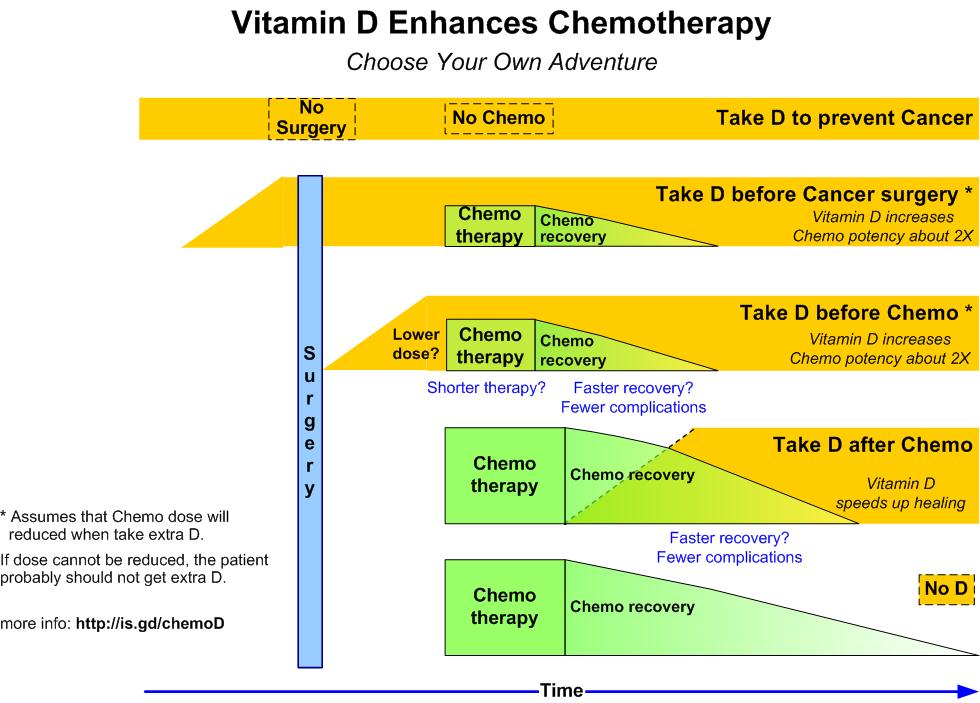Chemotherapy for Breast Cancer lowers Vitamin D levels
Vitamin D levels in Mediterranean breast cancer patients compared with those in healthy women.
Maturitas. 2018 Oct;116:83-88. doi: 10.1016/j.maturitas.2018.07.015. Epub 2018 Jul 29.

PDF is available free at Sci-Hub 10.1016/j.maturitas.2018.07.015
Pineda-Moncusí M1, Garcia-Perez MA2, Rial A3, Casamayor G3, Cos ML3, Servitja S4, Tusquets I4, Diez-Perez A5, Cano A6, Garcia-Giralt N7, Nogues X5.
1 IMIM (Hospital del Mar Research Institute), Centro de Investigación Biomédica en Red de Fragilidad y Envejecimiento Saludable (CIBERFES), Barcelona, Spain.
2 Department of Genetics and INCLIVA Biomedical Research Institute, University of Valencia, Valencia, Spain.
3 Internal Medicine Department, Hospital del Mar, Universitat Autònoma de Barcelona, Barcelona, Spain.
4 Cancer Research Program, IMIM (Hospital del Mar Research Institute), Barcelona, Spain.
5 IMIM (Hospital del Mar Research Institute), Centro de Investigación Biomédica en Red de Fragilidad y Envejecimiento Saludable (CIBERFES), Barcelona, Spain; Internal Medicine Department, Hospital del Mar, Universitat Autònoma de Barcelona, Barcelona, Spain.
6 Department of Pediatrics, Obstetrics and Gynecology and INCLIVA Biomedical Research Institute, University of Valencia, Valencia, Spain.
7 IMIM (Hospital del Mar Research Institute), Centro de Investigación Biomédica en Red de Fragilidad y Envejecimiento Saludable (CIBERFES), Barcelona, Spain. ngarcia@imim.es.
OBJECTIVES:
To evaluate the vitamin D status of postmenopausal women with early estrogen-receptor-positive breast cancer and to compare it with that of healthy postmenopausal women from the same Mediterranean region.
STUDY DESIGN AND OUTCOME MEASURES:
Data from 691 breast cancer (BC) patients in the B-ABLE cohort were analyzed after recent cancer intervention (recent-BC) or after a minimum of two years since this intervention (long-term-BC). Patients were also stratified by previous chemotherapy exposure (ChT+ and ChT-). Plasma levels of 25-hydroxyvitamin D [25(OH)D] (25(OH)D) were compared with data from 294 healthy women (non-BC) by linear regression to estimate β-coefficients using non-BC participants as the reference group. Age, body mass index and season of blood extraction were selected as potential confounders.
RESULTS:
Of the recent-BC patients, 23.7% had 25(OH)D deficiency, compared with 17.7% of the long-term-BC group, and just 1.4% of the non-BC participants. Most of the women were located in the insufficient 25(OH)D category regardless of study group. BC patients had significantly lower 25(OH)D levels than non-BC participants (adjusted β-coefficients: -4.84 [95%CI -6.56 to -3.12] in recent-BC, and -2.05 [95%CI -4.96 to -0.14] in long-term-BC). Among BC patients, the lowest 25(OH)D levels were found in the recent-BC (ChT+) group (p < 0.001). No differences were found between the long-term-BC (ChT-), long-term-BC (ChT+) and recent-BC (ChT-) groups. Among the BC ChT+ patients, the recent-BC group had significantly lower 25(OH)D levels than the long-term-BC group (p < 0.001).
CONCLUSION:
Severely reduced 25(OH)D levels were detected in patients with breast cancer, particularly after recent chemotherapy. These 25(OH)D levels had partially recovered over the long term, but still remained much lower than in the healthy population.
